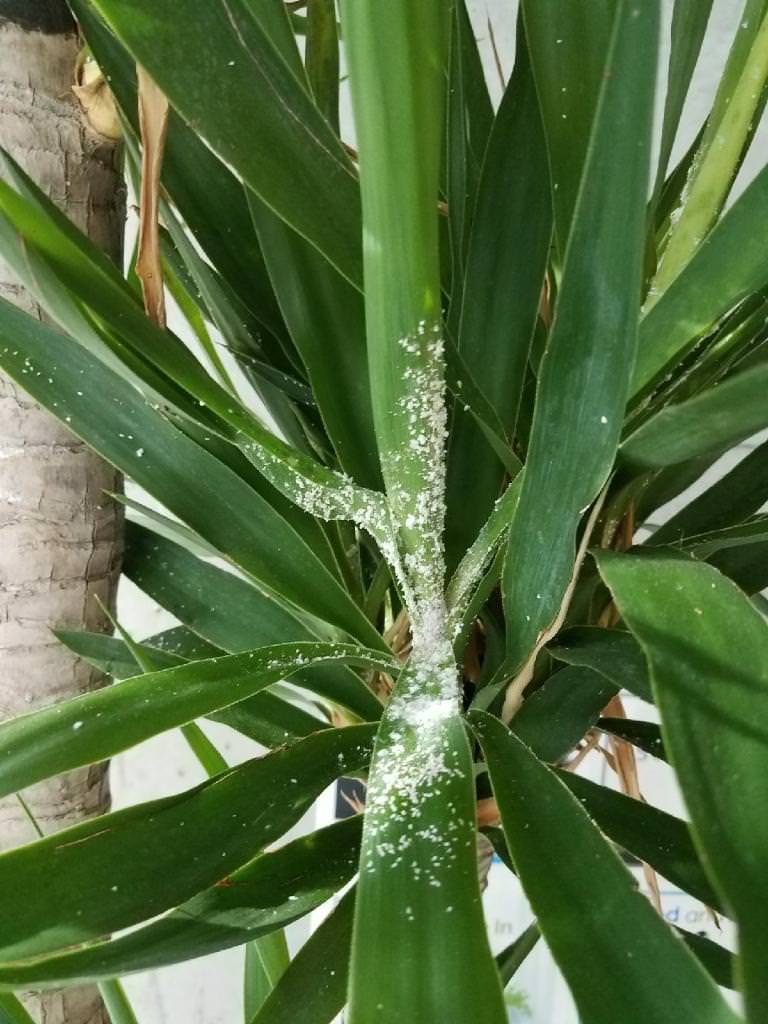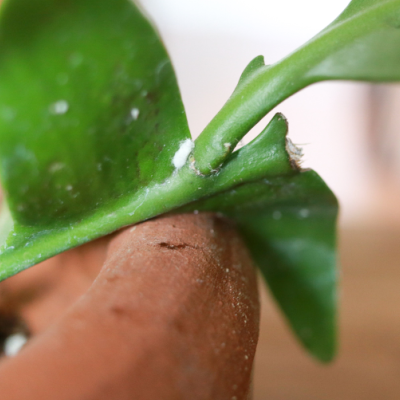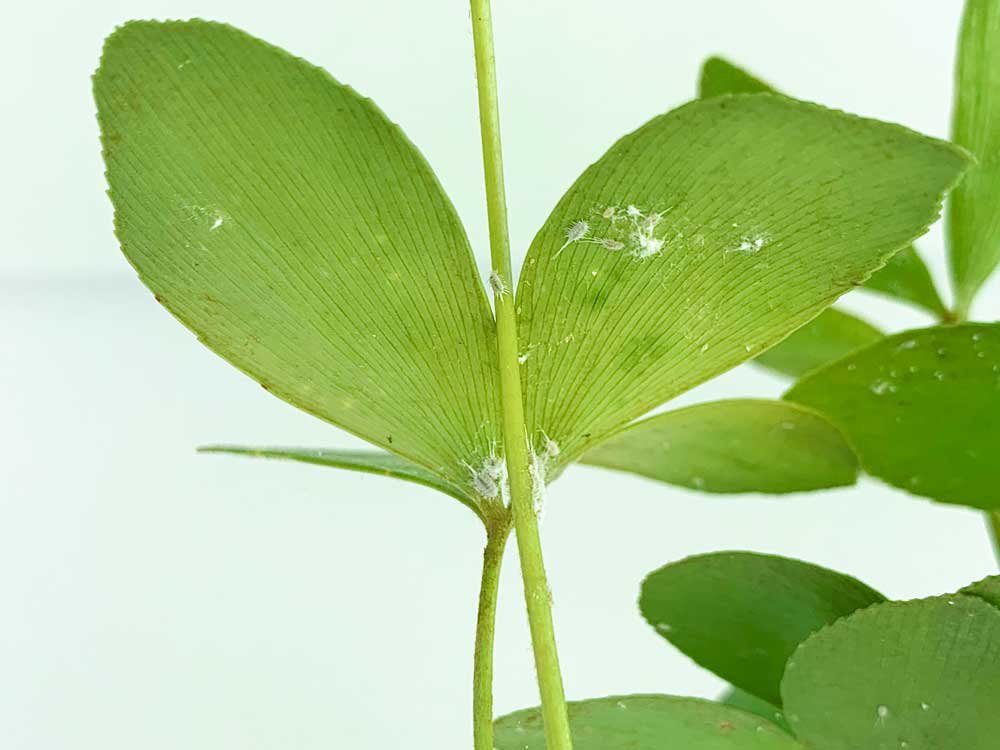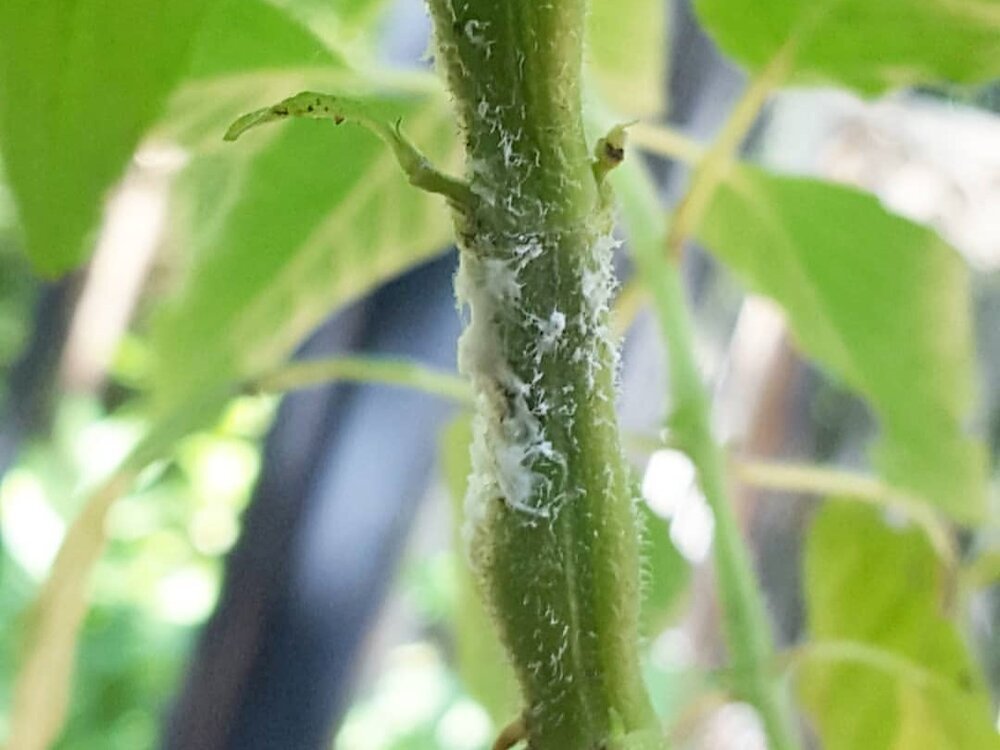MEALY BUG
Mealybugs, members of the family Pseudococcidae, are a group of soft-bodied scale insects that suck the sap out of plant tissue. They have oval shaped, segmented bodies, coated in wax, that loosely resemble small trilobites. These pests can frequently be found hiding in the nooks and crannies of leaves, and are often at the petiole insertion or nestled into the veins of leaves. While mealybugs are bright white in color and produce a fluffy looking cotton, they often go unseen when in low numbers due to their uncanny ability to hide. Most mealybug infections often go unnoticed until the infestation is moderate to severe, as many people don’t know to look for them.
(NOTE: IF YOU THINK YOUR PLANT HAS MEALY BUGS, PLEASE DO NOT BRING LOOSE CUTTINGS INTO THE GREENHOUSE, THIS HELPS US PREVENT THE SPREAD OF PESTS.)
TREATMENT OPTIONS
-
If there are only a few mealies on your plant, it may be possible to treat the infestation with only rubbing alcohol and some cotton swabs. It is a pretty straight-forward physical removal method. Simply saturate a cotton swab with rubbing alcohol and dab at the mealybug and cotton deposits. The mealybugs will usually stick to the tip and become slightly pink or orange in color. Rubbing alcohol kills the bug on contact, easily breaking through their waxy cuticle. This treatment needs to be done consistently, every time you see a bug. Check the plant often, at least once or twice a week, until you no longer see the bugs appearing. Make sure to use the cotton swabs, as dousing a plant with undiluted rubbing alcohol may damage the leaf cuticle. The swab concentrates the alcohol onto the pest rather than the leaf.
-
DISCLAIMER: It is recommended that you spot test the following treatments before treating the entire plant by applying the solution to a small portion of a leaf and allowing it to dry. Some plants are sensitive to liquid applied to their leaves.
This is the most popular approach to combating mealybugs. You can either purchase an insecticidal soap and follow the application instructions on the bottle, or you can make your own (see our spider mite treatment guide for the instructions on creating the solution). Check and make sure that any store bought treatments include mealybugs as one of the pests it is formulated to treat for. Not all insecticidal sprays will work for every pest.
Before applying the treatment, we recommend spraying as many of the bugs off with water to give the treatment the best chance at taking care of the infestation quickly.
It is necessary to use topical sprays multiple times for most mealybug outbreaks, as the adult bugs may have already laid eggs or be protected from the spray. Treating frequently at the beginning of management is crucial to mealybug eradication.
-
Another great option is diatomaceous earth. It is the fossilized sediment of microalgae, and works mechanically to kill bugs. Diatomaceous earth has two methods of action it accomplishes this with, physical damage and the ability to dehydrate through absorption. Diatomaceous earth is extremely small and sharp, and while not dangerous to humans or animals, the shards are highly dangerous for insects. It will shred or get lodged into the exoskeleton of insects as they pass over it. This causes the insect to either bleed out due to the wounds, no longer be able to move, and/or become severely dehydrated due to the diatomaceous earth absorbing the moisture in their bodies.
To apply, first wet the diatomaceous earth. After it is wet and has the consistency of a thin paste, gently spread it over the foliage and let it dry. It can be applied with gloved hands or be brushed on with a paint brush. It will look like the plant is covered in white powdery dust when dry, which is probably the biggest (and possibly only!) drawback to diatomaceous earth as a treatment option. Make sure to leave it like this for 1-2 weeks, reapplying the mixture if it is accidentally washed off or you still see the bugs moving or spreading. Only apply to plants that have active pests.
Another option for application would be to use a spray bottle. To use, mix the diatomaceous earth into a thin paste, then dilute until it is easy to spray. Coat the plant evenly, again leaving the residue on the plant for at least 1-2 weeks.
When the 1-2 weeks are up, simply wash the foliage with water. This can easily be done with a cool shower or simply by pouring room temperature water over the foliage. Diatomaceous earth rinses off easily, and should not leave any residue.
-
Integrated pest management is the practice of using beneficial insects to control pests. This option is probably the most expensive and unusual, but also one of the most effective options for control without any applied chemicals. The beneficial insects feed on the harmful bugs and do not harm plants, even if they eradicate their food source.
As far as predatory insects that are good choices for mealybugs, there is actually a beneficial insect commonly called the “mealybug destroyer” due to its voracious appetite for mealybugs. Mealybug destroyers are a type of lady beetle, closely associated with ladybugs. These beetles are not as flashy as their spotted cousins, but are rather black and brown in color.
Every mealybug destroyer larva will consume about 250 mealybug larvae before reaching their adult phase, performing pest control immediately upon hatching. Mealybug destroyers even sometimes lay their eggs in the cottony mounds that the mealybugs build to lay their own eggs, in order for the destroyer’s larvae to feed on the mealybug eggs. In their fully grown adult phase, reaching about twice the size of an adult mealybug, they will then begin munching on said adult mealybugs. Mealybug destroyers truly enjoy mealybugs at all stages of development and, resultantly, can diminish mealybug numbers rapidly.
Another excellent option to treat mealybugs are green lacewings. While the adults feed on pollen and nectar, the larvae feed on soft-bodied insects, including mealybugs, thrips, aphids, spider mites, and more!
-
This option is possibly the most effective, but also has some of the bigger drawbacks. Firstly, systemic insecticide should NEVER be used on plants that live outdoors or in environments using integrated pest management, even if it is only for part of the year. Systemic is dangerous to most insects, and will kill beneficial insects and pollinators in addition to the targeted pests. Secondly, systemic should be considered a last resort option if the other methods mentioned do not manage the pests and you do not want to dispose of the plant.
Systemic pesticides work by dissolving in water and being taken up by the roots, after which the pesticide then moves throughout the plant’s tissue and essentially turns the plant’s tissue into a pesticide. When the pest eats the plant, they also eat the pesticide. Unfortunately, this uptake means the systemic can also be present in a plant’s nectar and pollen, which is the biggest harm posed to beneficial insects.
ALWAYS follow the directions on the container, and make sure mealybugs are included in the list of pests it treats for. Use safe handling protocols when applying, such as using gloves, and document the date you applied the systemic for reference. Typically, systemics will take 1-2 weeks to become most effective, then last in the plant tissues from 6-8 weeks. This is usually long enough for pests to complete their life cycle. However, some infestations will take multiple applications.
One important thing to note before we cover treatment: if you find a mealybug on your plant, it is a good idea to isolate the plant from any others in your space. Mealy is extremely transmissible between plants, and the male mealybug, whose adult morphology varies greatly from the females, can actually fly.







